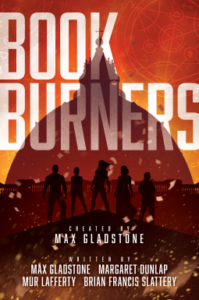The BookBurners review is a little different than my usual spiel, and not only because it’s part of an Irish Banana Blog Tour. BookBurners is not actually a traditional novel. The story (well, actually, stories) was first published at Serial Box in, you guessed it, serial form. Readers have the option of subscribing to a particular series and getting the latest episodes via an app for phone and tablet or purchasing them on Amazon individually, and now as a whole season. The whole thing is almost 800 pages, so it’s pretty whoppin’.
The sixteen episodes were written by a team of authors whose names you might recognize. And rather than the longer form of a novel, these episodes read like segments of a TV show, with a team of characters who face individual challenges resolved in each section but building together to form a larger story.
Confession time: Apparently I’m a doof and didn’t read the description of the series very thoroughly before agreeing to review it. Bookburners is not young adult or new adult literature. The main character is actually in her thirties. So… um. Oops? Despite this, I really enjoyed the format and got pretty hooked on the story and its characters as well. So, let me give you a bit of background about the book and then I’ll launch into my thoughts on it…
 Bookburners (Bookburners #1.1-1.16)
Bookburners (Bookburners #1.1-1.16)
Max Gladstone, Margaret Dunlap, Mur Lafferty, and Brian Francis Slattery
Saga Press / Simon & Schuster
Published January 31, 2017
Amazon | Barnes & Noble | Goodreads | Indiebound
About Bookburners
The critically acclaimed urban fantasy about a secret team of agents that hunts down dangerous books containing deadly magic—previously released serially online by Serial Box, now available in print for the first time!
Magic is real, and hungry. It’s trapped in ancient texts and artifacts, and only a few who discover it survive to fight back. Detective Sal Brooks is a survivor. She joins a Vatican-backed black-ops anti-magic squad—Team Three of the Societas Librorum Occultorum—and together they stand between humanity and the magical apocalypse. Some call them the Bookburners. They don’t like the label.
Supernatural meets The Da Vinci Code in a fast-paced, [fierce] character driven novel chock-full of magic, mystery, and mayhem, written collaboratively by a team of some of the best writers working in fantasy.
Though this isn’t at all my usual genre, I was totally hooked on the premise and immediately sucked into following the characters and their stories. I loved that individual episodes gave more time to explore some of characters more deeply (Grace and Asanti were my favorites) while still keeping the larger story moving forward.
One of the things that’s always tricky for me is a story that mixes faith with lore and secular ideas. So that was the biggest hurdle for me in reading this book. For the most part (see the spiritual content section for more specifics) the Catholic Church operates more like a political entity or force rather than a source of spiritual guidance and practice. This kind of storytelling can cause a lot of confusion about what practicing Catholics actually believe and value.
Apart from that, it’s a well-paced, edge-of-your-seat story. Again, not what I’d normally pick up, but I really enjoyed reading it. For the most part I found the writing to be really solid, too, not just in terms of plot and character development, but also in its use of clever and unusual descriptions that painted really vivid pictures. If you like adult supernatural thrillers, you definitely need to check this out. You can read the pilot issue for free here.
Recommended for Ages 16 up.
Cultural Elements
Asanti references her youth in the Democratic Republic of the Congo. Grace is Chinese. Liam is Irish. Father Menchú is Spanish.
Profanity/Crude Language Content
Extreme profanity used pretty infrequently– only a few times per episode.
Romance/Sexual Content
Sal engages in sex with a male friend. No descriptions of the event itself, but a few details leading up to and picking up afterward. While the two seem agreed to keep the experience “casual,” stress about the relationship and about their feelings for each other definitely affect their lives as a whole.
Spiritual Content
The team technically works for the Catholic church, but there’s not a lot of overlap in spiritual content in terms of practice or prayer. Father Menchú was at one time a practicing priest and remains faithful. At one point he prays for a team member. At another point, though, he asks a being he believes to be a demon for help. (Spoiler: it goes badly.) When he reflects on this later, another team member questions his take-away from the instance. Menchú believes the lesson was that he should never have asked this demon for aid. The teammate suggests that the real lesson is that he should have made a better deal.
On the whole, I wouldn’t say the book follows any real Catholic doctrine or practice very deeply. In fact, as in the above example, a lot of the spiritual content is muddled and mixed together with the idea that demons exist bound in books and other artifacts and that they can be controlled or contained using pure silver (often but not necessarily in the form of a cross necklace) and perhaps other benevolent magic (though this is contested within the team.) The demons themselves seem to be as much monsters from another realm as anything else. There’s no explanation connecting them to any Biblical understanding of demons other than that the teams fighting them are part of the Catholic Church.
In one episode, the team visits the Oracle at Delphi for information about the future.
Violent Content
Lots of battle scenes. In every episode the team faces some sort of encounter with a demonic force. Often the descriptions of battle feature gory bits and some creepy descriptions. For instance, in one episode, releasing a demon causes an apartment to become a living thing. The door breathes. The floor grows hair, skin, and even grabby fingers.
Drug Content
Sal and other team members (all over 21) drink alcohol together.
Note: I received a free copy of this book in exchange for my honest review.
 About the Authors
About the Authors
 Max Gladstone
Max Gladstone
MAX GLADSTONE has been thrown from a horse in Mongolia, drank almond milk with monks on Wudang Shan, and wrecked a bicycle in Angkor Wat. Max is also the author of the Craft Sequence of books about undead gods and skeletal law wizards—Full Fathom Five, Three Parts Dead, Two Serpents Rise, and Last First Snow. Max fools everyone by actually writing novels in the coffee shops of Davis Square in Somerville, MA. His dreams are much nicer than you’d expect. He tweets as @maxgladstone. Bookburners, which he wrote with Margaret Dunlap, Mur Lafferty, and Brian Francis Slattery, is available from Saga Press in January.
 Margaret Dunlap
Margaret Dunlap
Before joining the Bookburners, MARGARET DUNLAP wrote for ABC Family’s cult-hit The Middleman in addition to working on SyFy’s Eureka. Most recently, she was a writer and co-executive producer of the Emmy-winning transmedia series The Lizzie Bennet Diaries, and co-created its sequel Welcome to Sanditon. Her short fiction has previously appeared in Shimmer Magazine. Margaret lives in Los Angeles where she taunts the rest of the team with local weather reports and waits for the earthquake that will finally turn Burbank into oceanfront property. She tweets as @spyscribe. Bookburners, which she wrote with Max Gladstone, Mur Lafferty, and Brian Francis Slattery, is available from Saga Press in January.
 Mur Lafferty
Mur Lafferty
MUR LAFFERTY is the author of The Shambling Guides series from Orbit, including the Netfix-optioned The Shambling Guide to New York City and Ghost Train to New Orleans. She has been a podcaster for over 10 years, running award-winning shows such as I Should Be Writing and novellas published via podcast. She has written for RPGs, video games, and short animation. She lives in Durham, NC where she attends Durham Bulls baseball games and regularly pets two dogs. Her family regrets her Dragon Age addiction and wishes for her to get help. She tweets as @mightymur. Bookburners, which she wrote with Max Gladstone, Margaret Dunlap, and Brian Francis Slattery, is available from Saga Press in January.
 Brian Francis Slattery
Brian Francis Slattery
BRIAN FRANCIS SLATTERY is the author of Spaceman Blues, Liberation, Lost Everything, and The Family Hightower. Lost Everything won the Philip K. Dick Award in 2012. He’s the arts and culture editor for the New Haven Independent, an editor for the New Haven Review, and a freelance editor for a few not-so-secret public policy think tanks. He also plays music constantly with a few different groups in a bunch of different genres. He has settled with his family just outside of New Haven and admits that elevation above sea level was one of the factors he took into account. For one week out of every year, he enjoys living completely without electricity. Bookburners, which he wrote with Max Gladstone, Margaret Dunlap, and Mur Lafferty, is available from Saga Press in January.
Visit the Other Stops on the Blog Tour
Week 1:
2/6: The Irish Banana Review – Excerpt
2/7: Books, TV, and More … Oh My! – Spotlight
2/8: Fiction Fare – Q&A
2/9: Lisa’s Loves (Books Of Course) – Casting Couch
2/10: Resch Reads and Reviews – Guest Post
Week 2:
2/13: Just Commonly – Q&A
2/14: A Binding Attraction – Playlist
2/15: Kara the Redhead – Top 10
2/16: Wandering Bark Books – Spotlight
2/17: I Heart Romance & YA – Clothing Inspirations
Week 3:
2/20: I Love Books Club – Review
2/21: Novel Ink – Review
2/22: The Story Sanctuary – Review – you are here!
2/23: Never 2 Many 2 Read – Review
2/24: Owl Always Be Reading – Review









 Max Gladstone
Max Gladstone Margaret Dunlap
Margaret Dunlap Mur Lafferty
Mur Lafferty Brian Francis Slattery
Brian Francis Slattery








Will definitely be reading the pilot episode. I love the concept. Thank you!